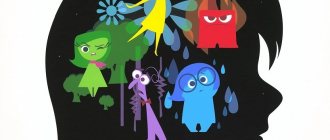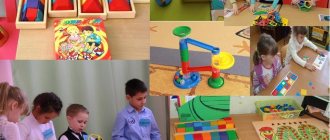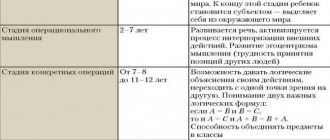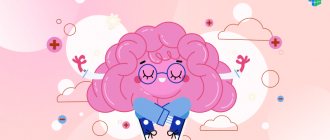Perception is a process that forms the image of objects and phenomena from the surrounding world into the structures of the psyche. This is a complete reflection of the qualities and inherent characteristics of an object and phenomenon. This is a kind of collapsed thinking. It is often interpreted not as a process, but as a result, that is, the image of the object itself. Perception is synonymous with perception, therefore the image of an object is formed with the help of the perception of primary sensations, certain knowledge, desires, expectations, imagination and mood. The main features of perception are objectivity, constancy, integrity, apperception, structure, meaningfulness, illusion, selectivity.
Perception has many synonyms: apperception, perception, evaluation, understanding, acceptance, contemplation.
Content
- Physiological mechanism of perception
- Properties of perception
- Principles of perception
- Perception factors
- Effects of perception
- Classification of types of perception
- Perceptual disturbances Illusions of perception
- Hallucinations Eidetism as a type of hallucination
If we compare the definitions of two mental processes, i.e. perceptions and sensations, then you can notice some features. For example, perception is a more complex process. If sensations reflect individual properties of objects, then perception is a holistic reflection. Thus, the result of perception is a holistic perceptual image of an object, and not a separate property of it.
Concept by D. Gibson
In the concept of the American psychologist D. Gibson, perception is interpreted as a process of obtaining information about the environment, as a result of which the uncertainty of the position of the organism in it decreases.
According to the scientist, perception is an active process, because there is no initial isomorphism between objects of the external world and their perception.
In this theory, the question of how perception is carried out is poorly developed. The weak development of this central moment for understanding the theory of perception explains the fact that there is almost no analysis of the development of perception in it and the reasons for this process have not been revealed.
Physiological mechanism of perception
The physiological basis of perception is the processes taking place in the sense organs, nerve fibers and the central nervous system. Under the influence of stimuli at the endings of the nerves present in the sensory organs, nervous excitation arises, which is transmitted along pathways to the nerve centers, and, ultimately, to the cerebral cortex. Here it enters the sensory zones of the cortex, which represent, as it were, the central projection of the nerve endings present in the sense organs. Depending on which organ the sensory zone is connected to, certain sensory information is generated.
Since perception is closely related to sensation, it can be assumed that it, like sensation, is a reflexive process. Ivan Petrovich Pavlov showed that perception is based on conditioned reflexes, i.e. temporary nerve connections formed in the cerebral cortex when receptors are exposed to objects or phenomena.
Temporary nerve connections that ensure the process of perception can be of two types: 1. Formed within the same analyzer; 2. Interanalyzer.
The first type occurs when the body is exposed to a complex stimulus of one modality (for example, a melody). The second type of neural connections formed under the influence of a complex stimulus are connections within different analyzers, the emergence of which Sechenov explained by the existence of associations. These associations in humans are necessarily accompanied by an auditory image of the word, thanks to which the perception acquires a holistic character.
conclusions
At preschool age, children experience a colossal leap in mental development, because during this period all cognitive processes are actively formed. Perception is the basic mental process on the basis of which all others (attention, thinking, speech, memory and imagination) are formed. Over the course of several years, children go from direct sensory perception to the ability to form a generalized idea of objects. If initially a child learns to recognize and evaluate what is in front of him at the moment, based on his own sensations and experience, then in older preschool age the level of development of perception allows him to purposefully study objects or phenomena, highlighting their properties. It is necessary to pay enough attention to the development of perception in children, because the child’s ability to learn largely depends on its level.
Properties of perception
1. Objectivity of perception
This is the ability to reflect objects and phenomena of the real world not in the form of a set of unrelated sensations, but in the form of individual objects. Objectivity is not an innate property of perception. The emergence and improvement of this property occurs in the process of ontogenesis, starting from the first year of a child’s life. According to Ivan Mikhailovich Sechenov, objectivity is formed on the basis of movements that ensure the child’s contact with the object (hand movements; eye movements that trace the contour of the object, etc.). Without the participation of movement, images of perception would not have the quality of objectivity.
2. Integrity of perception
Perception gives a holistic image of an object. It is formed on the basis of generalization of information received in the form of various sensations about the individual properties and qualities of an object. The components of sensation are so strongly interconnected that a single complex image of an object arises even when only individual properties or individual parts of the object directly affect a person. This image arises conditionally as a result of the connection between various sensations.
The integrity of perception is expressed in the fact that even with incomplete reflection of individual properties of the perceived object, the received information is mentally completed into a holistic image of a specific object.
3. Structurality of perception
The structure of perception is not just a collection of sensations. It reflects the relationship between various properties and parts, i.e. structure of the subject. Perception brings to our consciousness the structure of an object or phenomenon that we encounter in the real world. We can say that the structure of perception is a reflection of the specific relationship of the elements of the whole. For example, notes enter consciousness, and we recognize the melody, we recognize the triangle in the figure, because we know the aspect ratio of a given figure, or a certain letter remains the same letter despite a different writing style.
Structurality is associated with another property of perception - integrity.
4. Constancy of perception
Constancy is the relative constancy of the image of an object when the conditions of its perception change (for example, a car seems large to us at any distance from it). Constancy is observed to the greatest extent in the visual perception of color, size and shape of objects. Thanks to constancy, which manifests itself in the ability of the perceptual system (a perception system that consists of a set of certain analyzers) to compensate for changes in the conditions of perception, we perceive the objects around us as relatively constant.
A person repeatedly perceives a certain object, and this object is perceived under completely different conditions. This allows the system to maintain relative constancy of the properties of objects and phenomena. Without constancy of perception, people would not be able to navigate the world around them.
5. Apperception
Apperception is the dependence of perception on past experience and personality traits of the perceiver. A person’s knowledge and previous experience play a huge role in apperception. In the process of perception, in order to classify what you perceive, you will put forward and test hypotheses about whether an object belongs to a particular category of objects.
Thus, during perception, past experience is activated. Therefore, one object can be perceived differently by different people. The content of perception is determined by the task, motives of activity, interests. An essential place in apperception is occupied by attitudes and emotions, which can easily change the content of perception.
6. Meaningfulness of perception
Meaningfulness of perception is the property of human perception to endow the perceived object with a certain meaning. Perception is not determined simply by a set of stimuli, but is a constant search for the best interpretation of the data received.
We perceive objects that have a certain meaning. Regardless of the constantly changing content, we learn the same subject. Human perception, being a kind of awareness of objects and phenomena, includes the act of understanding and comprehension.
7. Activity (selectivity) of perception
Selectivity of perception lies in the fact that at any given time we perceive only one object or a specific group of objects, while other objects in the surrounding world are the background of our perception (not reflected in consciousness).
For example, while in a lecture hall, you listen to a lecture without noticing that someone behind you is discussing plans for the evening. Your perception is directed towards the lecture until you are asked about your plans. In this case, you will already be communicating and not listening to a lecture, i.e. perception will be directed towards the interlocutors.
Peculiarities of perception in younger preschoolers
In early preschool age, perception is characterized by the following features:
- The inseparability of a property from an object. The big fluffy tiger at the zoo will be called a kitty.
- When studying objects, the most vivid, memorable detail stands out. That is why the wide witch's hat in the picture turns all the elegant old ladies on the street into evil witches.
- A sharp change in the usual surroundings around a familiar object prevents the baby from identifying it. Mom and dad in ballroom dresses become strangers.
Such specificity is typical for children of 3-4 years of age; in the future, perception will become more differentiated, individual functions will be highlighted, and the whole will be fragmented into particulars.
Perception of space by children 3 - 4 years old
The difficulty of understanding space lies in the inability to touch, smell and see it. The first step is to recognize the “close” space, that is, the surrounding world at arm’s length with the toy.
Subsequently, the younger preschooler begins to understand the concepts of “far and close,” but they are not accurate. The small statues on the bridge may appear to be dolls, and the child may well ask the mother to get one of them.
According to research, in order for a preschooler to begin to correctly perceive space, he must first evaluate his own body in this world. Learn to distinguish and name arms and legs, understand which parts of the body are paired. An additional way to master the concept of space is the constant work of an adult aimed at indicating the direction. The more often the words “right”, “left”, “side”, “in front”, “above” are heard, the easier it will be for the baby to master orientation in space.
The next stage is tasks to compare length, width and height. Over time, the child begins to solve such tasks “by eye,” demonstrating an understanding of what space is and how people and objects are located in it.
Color perception
The difference in colors is available to the baby from an early age. Now we are not talking about the finest shades, but it highlights the main tones of the spectrum.
At 3-4 years old, a preschooler clearly distinguishes 4 primary colors:
- Red;
- Yellow;
- Blue;
- Green.
This aspect is associated with the age-related feature of seeing the main thing, discarding the unimportant, that is, incomprehensible and unknown shades. Data and reference shades are learned casually, without special training. But in order for the baby not to suffer from “poverty” of color perception, the names of the remaining tones and shades must be named and shown to him.
Children tend to replace color with the concepts of “beautiful” and “ugly,” which results in pictures where the shades of objects do not closely correspond to reality. In this age period, colors are discarded as an unimportant factor, and form becomes the basis.
Therefore, the development of color perception should consist of exercises where the simplest tasks of adding up an elementary color figure are replaced by more complex ones.
Principles of perception
A group of psychologists, together with Max Wertheimer, a German psychologist and founder of Gestalt psychology, formulated the laws of perception, which became the theoretical basis of Gestalt psychology.
1. The principle of proximity Elements that are close to each other in space and time and that seem to us to be united in groups, we perceive together.
2. Principle of Continuity There is a tendency to follow a direction that allows observed elements to be linked into a continuous sequence or a specific orientation. In the figure we see not just individual dots, but two intersecting lines.
3. Principle of similarity Similar elements are perceived by us together, forming closed groups. Because of the color, we perceive the points in the figure as rows rather than columns.
4. Closure principle There is a tendency to complete unfinished items and fill empty spaces.
5. The principle of simplicity (the law of content, the principle of good form, the law of pregnancy) We perceive and interpret composite or complex objects as the simplest form or a combination of the simplest forms. In the figure we see three different simple figures, and not one complex one.
Pregnant gestalt means that in any conditions we strive to see the figures as complete as possible.
6. Figure-ground
We strive to organize our perception in such a way as to see the object (figure) and the background against which it appears. The object is brighter, more significant, and noticeable.
Peculiarities of perception in older preschoolers
Senior preschool age is marked by the presence of formed spatial representations. The child is well oriented in space, perceives distances and relationships between objects, and is able to visually model part of a specific room. He is also able to construct a model of the plot of a story or fairy tale.
The future schoolchild is already able to evaluate such an abstract concept as time, as well as see the world around him from an aesthetic point of view. It is these two areas that require the most attention.
Perception of time
The main features of perception in children of senior preschool age are the awareness of the combination of space and time. However, the inability to hear or touch these quantities leads to their prolonged recognition.
A child of 5-6 years old is able to remember time periods: yesterday, today, tomorrow, minute, hour, but there are no skills in using these concepts. The uniqueness of the perception of time is due to the fact that the child does not have the opportunity to manipulate it in a direction, and the terms are simply words that do not have a visual expression.
At this age, time indicators of the sequence of events are still poorly differentiated - yesterday, tomorrow, the day after tomorrow. The future tense is already realized, but the past causes difficulty. Preschoolers are happy to say who they will be when they grow up, what they will have, what they will do. They perceive the past discretely and emerge in the images of remembered events.
Adults will help the child perceive small periods of time if they correlate his activities with the time interval: draw a house with a garden in 10 minutes, sit at the table in 3 minutes, brush your teeth in 1 minute.
Aesthetic perception
But aesthetic perception blossoms “lushly.” In older preschool age, every child is a creator. Children sculpt, draw, design, these activities help them understand the world better.
Much of the credit for this activity goes to visual perception. An older preschooler learns to examine objects holistically, tracing the outline and isolating details.
This information becomes a model that the child follows in his drawing and modeling.
If a five-year-old child’s judgment about aesthetics is determined by appearance, and objects are evaluated according to the “like or dislike” principle, then at 6-7 years old a preschooler pays attention to artistic composition and color compatibility. For example, in a painting he is already able to capture characteristics that are not on the surface, which the artist put into the content.
The task of parents and educators is not just to inform the child about the beauty of this or that object. It is important to explain in clear words what exactly ensures the aesthetics of a phenomenon, the relationship between individual features and the overall result.
Regular activities of this nature help to cultivate a sense of beauty in a little person. He will learn to see beauty in the sound of drops on glass or falling leaves.
Perception factors
Our perception depends on external and internal factors.
a) External factors: - intensity of the stimulus; — size of the stimulus; — stimulus contrast; - movement of the stimulus; - recognition of the stimulus.
b) Internal factors: - human attitude; — needs; - experience; — personal characteristics (self-esteem, left- or right-handedness, optimism-pessimism, etc.); - effects of perception.
How do children of middle preschool age (4-5 years old) perceive the world?
By the age of 5, children achieve significant success in their ability to perceive various parameters of the world around them:
- There are 7 or more colors;
- Have an idea of light and dark tones, “warm” and “cold” shades;
- Know the basic geometric shapes (circle, square, triangle, rectangle);
- Can compare objects by size (large, smaller, small);
- They begin to form the concept of time (today, yesterday, tomorrow, minutes, hours, days, weeks), but they are not yet able to apply knowledge about these abstract concepts into the life of a four-year-old;
- The perception of other people depends on their popularity in society and their relationship with the baby. Mom will always be perceived by the baby as the kindest and most beautiful.
Effects of perception
Let us highlight the main effects (errors) of perception:
The projection effect is the ability of people to attribute their own advantages to a pleasant person, and their shortcomings to an unpleasant person. Those. the effect suggests that other people have the same qualities as the perceiver.
The halo effect is the formation of a specific attitude towards a person through the directed attribution of certain qualities to him; information received about a person is superimposed on the image that was created in advance. Those. the effect is to extend the general opinion to the particulars.
The primacy and recency effect is the tendency of people, when faced with conflicting information about another person, to give more weight to information received first (if a stranger is perceived) or more recent information (if an old acquaintance is perceived).
The effect of physiognomic reduction is the ability of people to draw conclusions about the character and psychological characteristics of a person based on the features of his appearance.
Classification of types of perception
1) Separation by modality: - visual perception; - auditory perception; - tactile perception; - taste perception; - olfactory perception. Combinations of different types of perception are possible.
2) Division by object of perception: - perception of space (includes the perception of size, shape, relative position of objects, their relief, distance and direction); — perception of time (reflection of the duration and sequence of phenomena or events); — perception of movement (reflection of the direction and speed of the spatial existence of objects); — perception of speed; - perception of direction; - perception of a work of art; - perception of the main phenomena of human life.
3) Separation by goal: - intentional (voluntary) perception (we are guided by a previously set goal or task); - unintentional (involuntary) perception (lack of volitional activity and purpose).
4) Division according to the participation of other psychological formations: - emotional perception (perception associated with emotions and feelings); — rational perception (perception subordinate to the thinking process).
Perception disorders
1) Illusions are erroneous perceptions of real objects and phenomena. They can be auditory, visual, olfactory, etc.
Under certain conditions, they occur in most people and can be caused by physical (perception of a spoon in a glass of tea that appears broken), physiological (split images of objects if you press on the side of the eyeball at the moment of perception) and psychological reasons (overestimation of vertical lines compared to horizontal ones) .
Illusions of perception
a) Ebbinghaus illusion
This is an optical illusion of perception regarding size. Two objects of the same size can look different. If one object is placed among smaller objects, it will appear larger than if the same object is placed among larger objects.
b) Ponzo illusion
This is an optical illusion of perception. Mario Ponzo suggested that the human brain determines the size of an object by its background. He drew two identical segments against the background of two converging lines, like a railway track stretching into the distance. As a result, horizontal lines are perceived differently.
c) Aristotle's illusion
This is an illusion of touch. A small object (pencil) is placed between (under) crossed fingers (it’s easier to use the middle and index fingers) so that it touches one finger on the inside and the other finger on the outside. When you move your fingers (and hand) over an object (back and forth), after a while you get the impression that your fingers are touching 2 objects.
d) Zellner illusion
An optical illusion in which parallel lines intersected by a series of short diagonal lines appear to diverge.
e) Müller-Lyer illusion
An optical illusion that occurs when observing segments framed by arrows. The segment framed by the “points” seems shorter than the segment framed by the “tail” arrows.
f) Poggendorff illusion
An optical illusion where the red line is a continuation of the black line, rather than the blue one.
Hallucinations
2) Hallucinations are erroneous perceptions in the absence of an object.
Hallucinations occur with alcohol abuse (delirium delirium), drugs, psychostimulants (LSD, cocaine, etc.), medications (for example, antidepressants), mental illness (schizophrenia, epilepsy), organic brain lesions, cataracts (Charles hallucinations). Bonnet).









